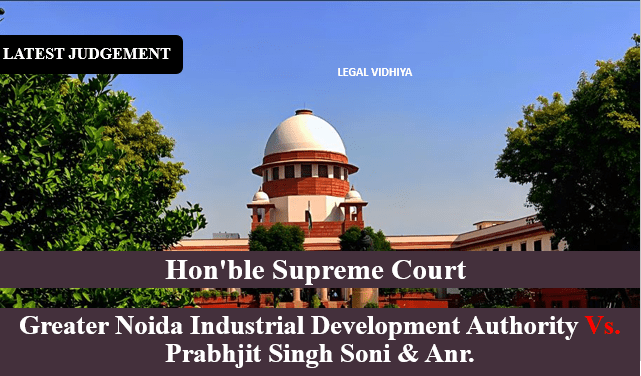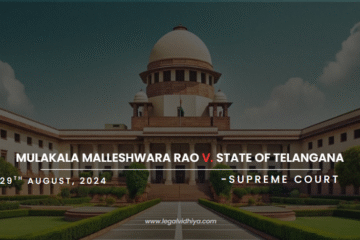
| CITATION | CIVIL APPEAL NOS.7590-7591 OF 2023 |
| DATE OF JUDGMENT | 12 FEBRUARY,2024 |
| COURT | SUPREME COURT |
| APPELLANT | GREAT NOIDA INDUSTRIAL DEVELOPMENT AUTHORITY |
| RESPONDENT | PRABHJIT SINGH SONI AND ANR. |
| BENCH | CHIEF JUSTICE DR. DHANANJYA Y.CHANDRACHUD , JUSTICE J.B. PARDIWALA, JUSTICE MANOJ MISHRA |
INTRODUCTION
The Supreme Court, in a recent judgment titled Greater Noida Industrial Development Authority vs. Prabhjit Singh Soni, addressed two key issues related to India’s insolvency and bankruptcy framework:
1. NCLT’s Power to Recall Orders:
The court upheld the existing view that the National Company Law Tribunal (NCLT) has the inherent power to revisit its own orders under certain circumstances. This power is crucial to ensure justice and prevent situations where errors or misrepresentations might lead to unfair outcomes.
However, the court clarified that this power is not absolute and can only be exercised in limited situations, such as:
a. Lack of proper notice: If a party involved in the case wasn’t adequately informed about crucial proceedings.
b. Misrepresentation of facts: If the decision was based on inaccurate or misleading information.
c. Error apparent on the face of the record: If the order contains a clear and obvious mistake.
2. Specifics of the Case:
The case involved the Greater Noida Industrial Development Authority (GNIDA) and JNC Construction, a company undergoing insolvency proceedings. GNIDA claimed they were owed a significant sum (over 43 crores) by JNC for leasing land for a project. They argued they were a “financial creditor” deserving higher priority in recovering their money.
However, the insolvency professional categorized GNIDA as an “operational creditor” (owed money for services) instead. GNIDA challenged this classification and a court order approving JNC’s revival plan, but lost in lower courts.
FACTS OF THE CASE
- A government agency (GNIDA) acquired land for development and leased a plot to JNC Construction (the Company) for 90 years, with the payment spread out in installments .
- The Company failed to make these payments and received a warning to pay or lose the lease.
- Due to the Company’s financial troubles, a legal process called CIRP (Corporate Insolvency Resolution Process) was initiated.
- GNIDA claimed they were owed a large sum of money (over 43 crores) and categorized themselves as a “financial creditor” (owed money for loans or investments).The insolvency professional (RP) disagreed and considered GNIDA an “operational creditor” (owed money for goods or services).
- GNIDA didn’t re-file their claim under the new category and a plan to revive the Company was approved by the court. GNIDA challenged their categorization and the approved plan but lost both at the lower court (NCLT) and the appeals court (NCLAT).
Key Points:
- The dispute revolves around the type of creditor GNIDA is (financial or operational) and the amount they are owed.
- GNIDA believes they deserve higher priority in recovering their money as a financial creditor, while the court classified them as operational.
- GNIDA’s challenge to the court’s decisions was unsuccessful.
ISSUE RAISED
- Is the appellant in this case seeking official acknowledgment as a financial and secured creditor, and what specific arguments do they present regarding the failure of the proposed resolution plan to recognize their claim?
- What concerns are raised by the appellant regarding the lack of notification about crucial Committee of Creditors (COC) meetings related to financial resolutions, and how does this impact their position in the resolution process?
- Can the timeliness of the appellant’s recall application be called into question, and is there an ongoing inquiry to determine if it was submitted within the acceptable timeframe?
- In what ways is the appellant challenging the fairness of the resolution plan, particularly concerning the lack of notification and the perceived inadequate consideration of their claims by the relevant legal bodies?
CONTENTION OF APPEALENT
(a) Claim Submission:
The appellant emphasizes that they submitted a valid claim with proof on January 30, 2020, asserting their status as a financial creditor with a security interest in the assets of the Corporate Debtor (CD). Even if the appellant is not considered a financial creditor, they argue that the resolution plan should have recognized their claim as that of a secured creditor. However, the order of approval dated August 4, 2020, incorrectly describes the appellant as someone who did not submit their claim.
(b) Lack of COC Meeting Notification:
The appellant contends that they were not notified about the Committee of Creditors (COC) meetings, hindering their ability to participate in the resolution process. They argue that this lack of notification invalidates the resolution plan.
(c) Failure to Consider Appellant’s Rights:
The appellant asserts that the adjudicating authority, when approving the resolution plan, failed to consider whether the plan adequately accounted for the appellant’s claim, statutory charge over the CD’s assets, and ownership and statutory rights over the land. They argue that this oversight renders the approval order invalid.
(d) Timeliness of Remedial Actions:
The appellant disputes the finding that they delayed in pursuing remedies. They argue that they promptly filed I.A. No.344/2021 on October 6, 2020, upon receiving information about the plan’s approval on September 24, 2020. Additionally, I.A. No.1380/2021 was filed on March 15, 2021, immediately after the suspension of the period of limitation was lifted, following a court order on March 8, 2021. The appellant contends that these actions were timely and in accordance with the legal framework.
CONTENTION OF RESPONDENTS
- In defense of the respondents, Dr. Abhishek Manu Singhvi argues that a crucial point is whether the money owed to an Industrial Area Development Authority, like the appellant, for lease/allotment-related payments, is considered a financial debt. He points to a previous court decision in Anand Sonbhadra, which, according to him, settled this matter by stating that such dues do not qualify as a financial debt. Consequently, he argues, the appellant shouldn’t have had voting rights in the Committee of Creditors (COC).
- Moreover, Singhvi contends that since the appellant based its case solely on claiming financial creditor status, its challenge to the approval order lacks a valid foundation. He emphasizes that the decisions made by the COC, including its commercial wisdom, are beyond the scope of judicial review. Lastly, Singhvi asserts that once the Adjudicating Authority approves a resolution plan that accounts for the appellant’s interests, attempting to question it through a recall application is not permissible. In simpler terms, the respondents argue that the appellant’s claim to financial creditor status is unfounded, and challenging the approval of the resolution plan, especially based on this claim, is not valid or justifiable in court.
JUDGEMENT
- In this legal matter, the appellant, Manoj Misra, has filed appeals under Section 62 of the Insolvency and Bankruptcy Code, 2016, challenging the decision of the National Company Law Appellate Tribunal (NCLAT).
- The background of the case involves the appellant, a statutory authority, acquiring land for development. The appellant leased a plot to M/s. JNC Construction (the Corporate Debtor), which later defaulted on payments. This led to the initiation of the Corporate Insolvency Resolution Process (CIRP) against the Corporate Debtor.
- The appellant, claiming to be a financial creditor, submitted a substantial claim for unpaid instalments. However, the Resolution Professional (RP) treated the appellant as an operational creditor, leading to disputes. The appellant objected to the resolution plan, the RP’s decision, and the lack of notification about Committee of Creditors (COC) meetings. The NCLT, in its order dated 5.4.2021, rejected the appellant’s applications, citing a delay in challenging the RP’s decision and stating that it was now impermissible to decide on the claim due to the completion of CIRP.
- Displeased with the NCLT’s decision, the appellant appealed to the NCLAT, arguing that they should have been recognized as a financial creditor, emphasized their secured creditor status, disputed the handling of their claim, and criticized the lack of COC meeting notifications. The NCLAT, however, dismissed the appeal, highlighting that the appellant was informed about its operational creditor status and the need to file a claim but failed to do so in the required format. The NCLAT also emphasized the timing of the appellant’s challenges, suggesting a lack of diligence, and deemed the commercial wisdom of the COC as non-justiciable.
In conclusion, the appellant’s appeals were directed against the NCLAT’s decision, asserting issues related to creditor status, handling of claims, and procedural matters during the insolvency proceedings.
ANALYSIS
The Supreme Court addressed three key issues in the case:
1.Tribunal’s Power to Recall Orders:
The Court clarified that a Tribunal, unless expressly prohibited, possesses inherent powers to recall its orders in the interest of justice. Such authority, rooted in Section 60(5)(c) of the Insolvency and Bankruptcy Code (IBC) and Rule 11 of the NCLT Rules, should be used judiciously, without turning into a rehearing tool.
2.Timeliness of Application:
The Court determined that the application to recall the order approving the resolution plan was not time-barred. It was filed promptly upon the appellant learning about the NCLT’s approval, adhering to the extended limitation periods due to the Covid-19 pandemic.
3.Grounds for Recalling Order:
On the merits, the Court found valid grounds to recall the NCLT’s order. The approved resolution plan didn’t comply with the Code and Regulations, as it wrongly stated the appellant hadn’t filed a claim, contrary to the evidence. The Court emphasized that the form of filing is less critical than substantiating the claim with evidence. Furthermore, the plan failed to acknowledge the appellant’s status as an operational and secured creditor, violating legal requirements.
CONCLUSION
The three-judge Bench upheld the existing perspective that the National Company Law Tribunal (NCLT) possesses the authority to reconsider its own decision in order to serve the interests of justice and prevent potential abuse of the court’s processes. This allows litigants to pursue legal remedies directly before the NCLT after the approval of a resolution plan, instead of necessarily filing an appeal before the National Company Law Appellate Tribunal (NCLAT) in certain circumstances.
In conclusion, the Supreme Court set aside the NCLT’s approval of the resolution plan, directing a reconsideration by the committee of creditors to ensure compliance with the Code and Regulations.
BY: Smriti Bhardwaj, DES Navalmal Firodia Law college, Pune ,Maharashtra
Disclaimer: The materials provided herein are intended solely for informational purposes. Accessing or using the site or the materials does not establish an attorney-client relationship. The information presented on this site is not to be construed as legal or professional advice, and it should not be relied upon for such purposes or used as a substitute for advice from a licensed attorney in your state. Additionally, the viewpoint presented by the author is of a personal nature.




0 Comments